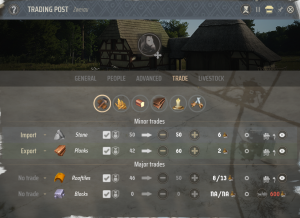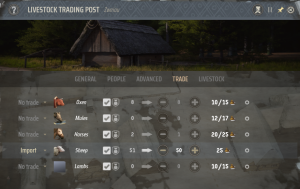⚠ NOTICE
The game has been released in Early Access on 26th of April, 2024.
Please keep in mind that any information provided on this Wiki may be incomplete or subject to change as the game progresses.
Trade: Difference between revisions
No edit summary |
m (added cats) |
||
| Line 31: | Line 31: | ||
==History== | ==History== | ||
[[Category:Gameplay]][[Category:Mechanics]] | |||
Latest revision as of 18:48, 17 July 2024


The trading system is a gameplay mechanic that allows players to import and export goods and livestock from foreign lands and other regions on the map using Manor Lord's main currency, regional wealth. Trade managed by the player via the trading post for regular goods and the livestock trading post for livestock.
Mechanics
Importing
Importing allow players to get livestock and goods from traders for a price, paid in regional wealth, which is controlled by the global market supply of said good. If there is not trade route for a good, a travelling merchant may stop by the trading post and exchange the specified regional wealth for a certain number of the good.
Importing of a certain good or livestock can be done in the trading post or livestock trading post menus. Beside the good for animal name will be a toggle where the import option must be clicked.
Exporting
Exporting a good or livestock is the opposite of importing, as it is an exchange of goods or livestock for regional wealth, and has the same mechanics as importing.
It can also be done via the trade menu of the trading post or livestock trading post and the dropdown toggle.
Trade routes
Trade routes, when purchased for regional wealth (this can be halved with the Trade Logistics development upgrade), allow for a free merchant to visit trading posts in the region the player is in at regular intervals and the good the route was purchased for.
All major trades (goods that typically require many steps to produce) require the player to purchase a trade route in order to be traded.
Global market supply
The global market supply controls the import and export price of a good or animal and is based on how much of said good or animal is in the market at one time. If there is too much product in the market, prices will fall, exporting will make less money but importing will be cheaper and vice versa, too little causes the market to become undersupplied.
The global market supply status of a good or animal can be viewed via the small dot to the right of the item in the trading menu of a trading post or livestock trading post.
 Hooded Horse Wikis
Hooded Horse Wikis